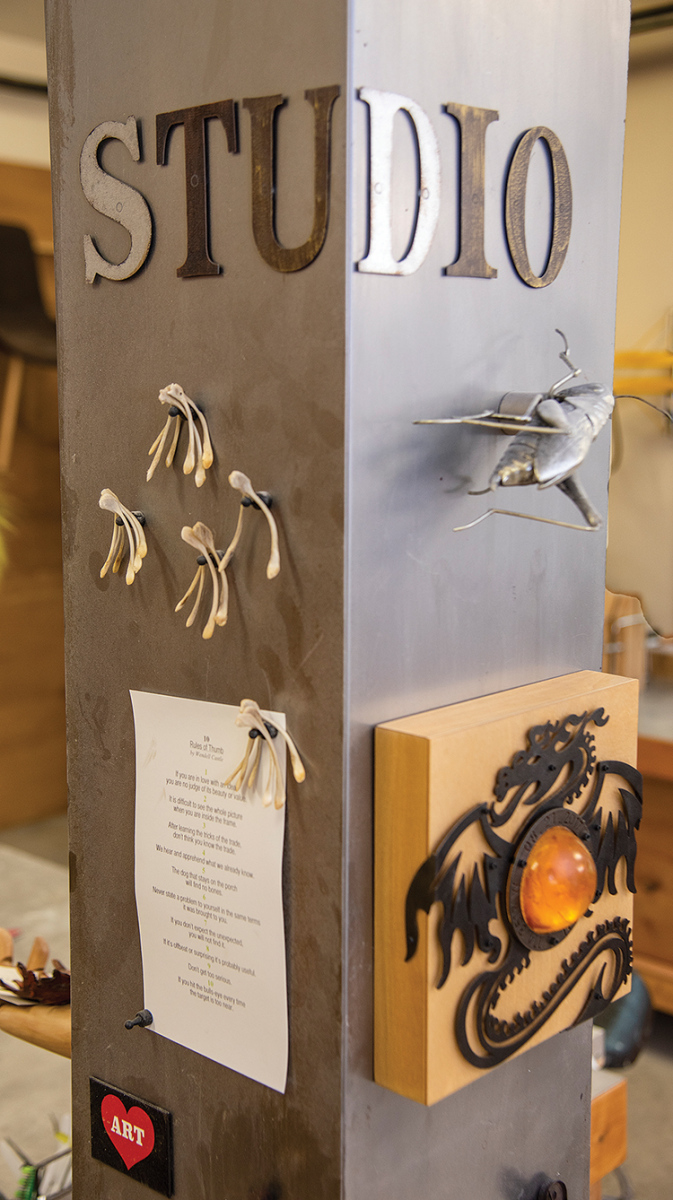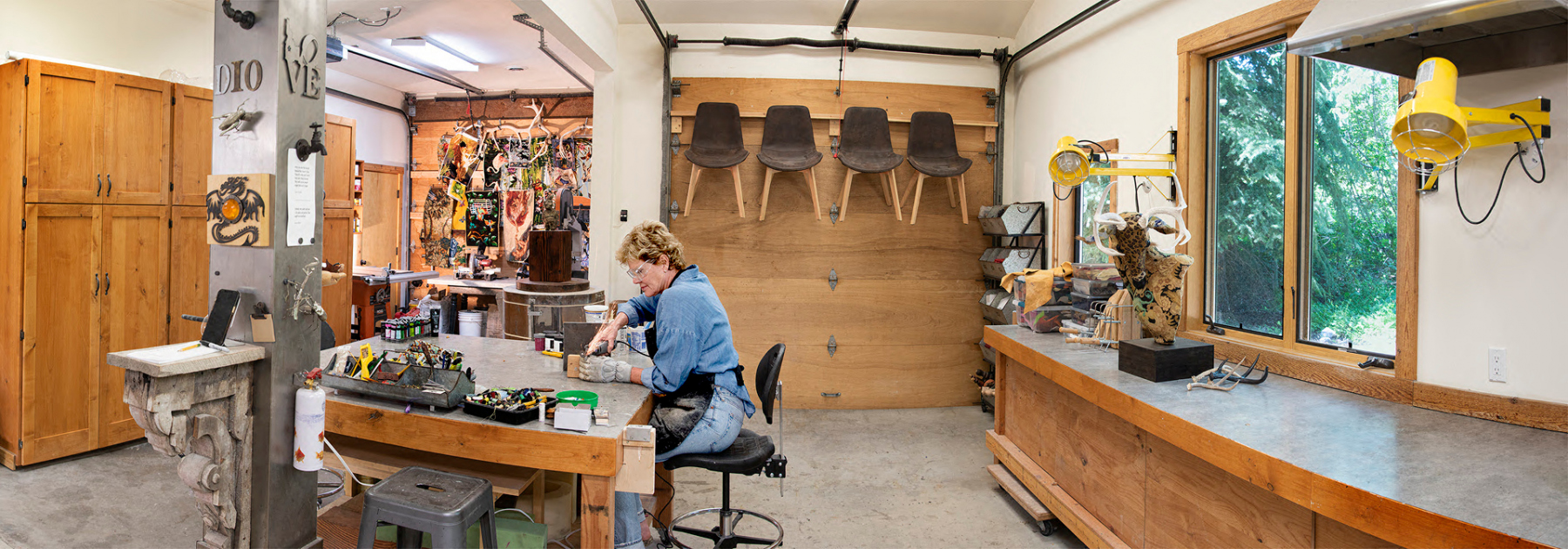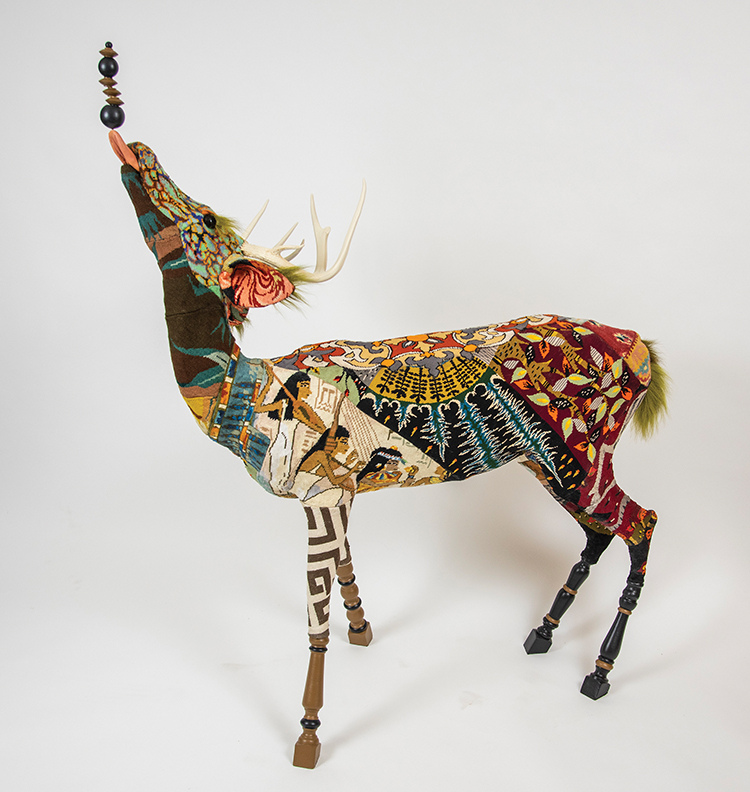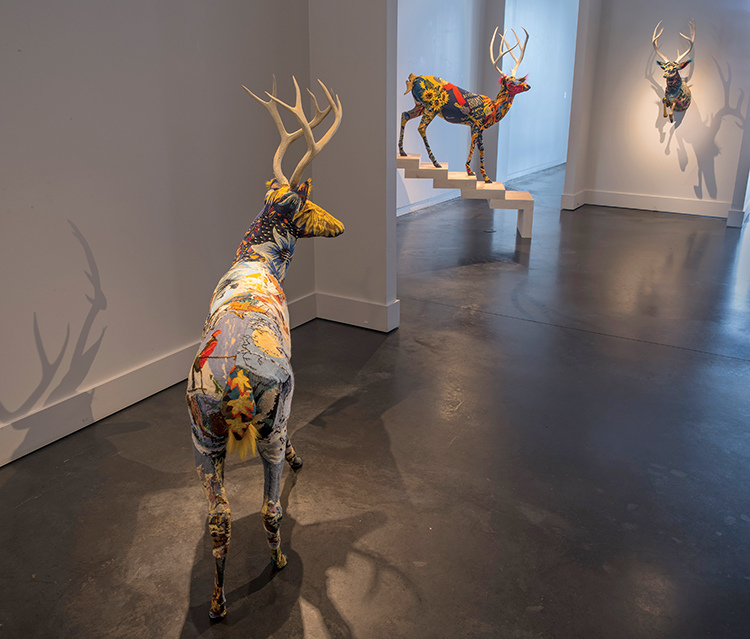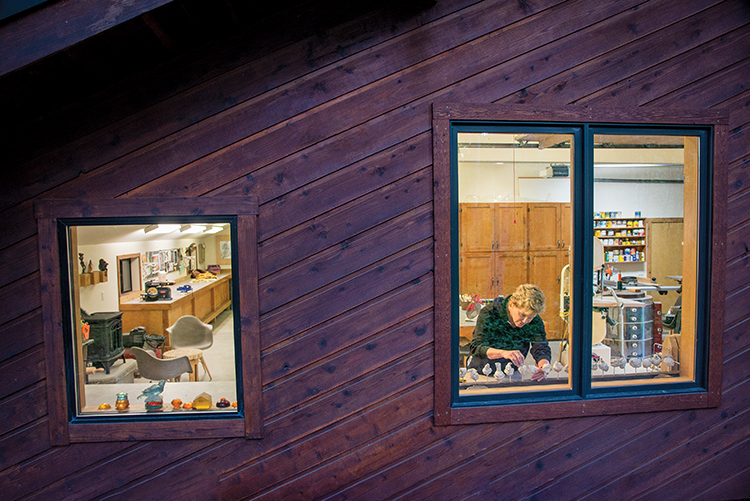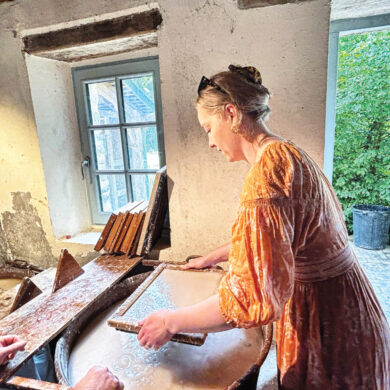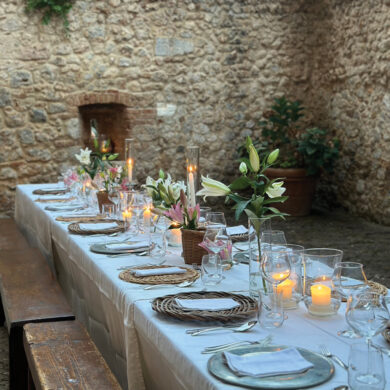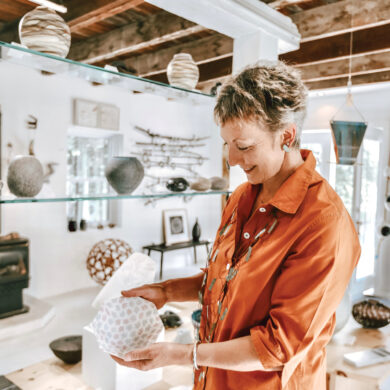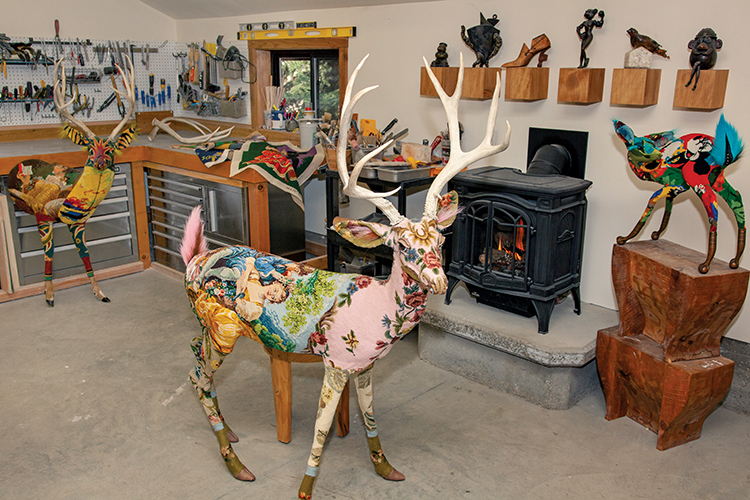
Makers have a way of finding spaces in which to create. Whether on their laps in front of the television, on kitchen tables cleared before dinner, in garages and basements, or yards and laundry rooms, artists find spaces to make their work. By necessity, I have created art in all these places. Today, I have a designated studio attached to my home that is my creative space and my sanctuary — but it wasn’t always that way.
I have been a maker for as long as I can remember. From homemade paper dolls drawn with crayons and cut out with children’s scissors to museum installations, I have had what I call busy hands. My adolescent bedroom was my first studio. Filled with macramé projects rigged to the hanging rod in my closet and combustible candle-making supplies — it was the ’70s, after all — my purple-painted bedroom was my first creative space.
Later, my dorm room became the place where assignments from college art professors were tackled. Trying, mostly unsuccessfully, to keep to my half of the tiny room, I stacked large canvases against the wall and piled toxic painting supplies in the corner. I painted while sitting cross-legged on the floor and cleaned paintbrushes in the communal bathroom down the hall.
Today, I would consider these hardships, though that never occurred to me at the time. In reality, I think this is just how art is always made — in the space available.
During those student years, whenever I wasn’t making art, I was trying to figure out how I might make a living in the world. As graduation approached, my romantic idea of supporting myself by painting in a loft in SoHo soon gave way to the imminent and pressing reality of monthly rent and car payments. The pursuit of a career in fine art turned into the next-most-palatable idea — graphic design.
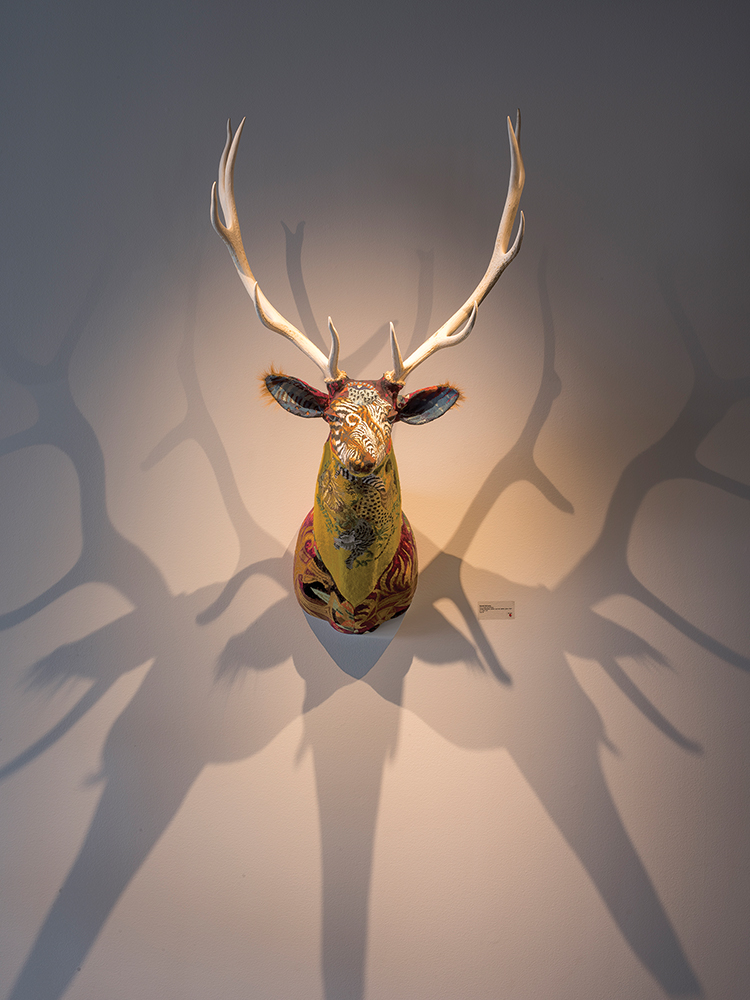
Later, I was to learn from colleagues in the advertising and design field that they had made similar pivots to become employable. The sad trade-off that I witnessed, however, was that with long workdays and adult commitments at home, few of us were creative in our off-hours.
Years later, when motherhood kept me home with young children, I began to sketch during naptime. Drawing was the one creative outlet that didn’t require a designated space, wasn’t messy, and didn’t require lengthy cleanup — crucial elements for the short and unpredictable time spans available to me. Interestingly, instead of making traditional two-dimensional sketches from my imagination or my immediate surroundings, I found myself drawing three-dimensional objects, essentially trying to compress sculpture onto a page. This initial connection to sculpture was a eureka moment for me and led to much of the work I create today.
As soon as my children entered school, I purchased a bag of clay and never looked back. I bought a kiln and checked out library books — remember those, before YouTube videos? — on how to sculpt and fire clay. My studio was in the mudroom off the laundry room, and as appropriate as that sounds for working with clay, it was a tiny space without a sink. Clay sculptures were set to dry in the laundry room — where else but on the dryer? During this time of experimentation in three dimensions with an unfamiliar material, I began to find my voice — and my nerve.
Up to this point, I would never have called myself an artist, at least not out loud. A maker, a creative spirit perhaps, but not an artist. An artist, a real artist, has to have work in galleries. Or so I thought. I feared that if I called myself an artist, people would ask, “Where is your work being shown?” For years, much of my work was gifted to (or foisted on) friends and relatives, not sold in galleries. To this day, I sometimes find that early work in the homes of friends and family and cringe.
“Inspiration exists, but it has to find you working.”
— Pablo Picasso
At a certain point, I realized that my art could not mature without some critical input, so I made the commitment to return to school. Pursuing a graduate degree in middle age had a significance for me beyond my initial intentions. I was after the same MFA as my younger peers, and I was interested in academic challenge for its own sake, but what I also received was an eye-opening look at my own work and a kick in the pants.
In school, I was exposed to conceptual work and rigorous art theory. I began to think about my work instead of just making it. Additionally, for the first time in my life, I committed to creating a workspace that nurtured me.
Studio is a word used in a number of different disciplines.
When people enter my studio, they generally call it a workshop. It looks like a cross between a woodshop, an elementary school art room and an artist’s studio. It began as a large three-and-a-half-car garage attached to my home.
Unwilling to give up all my indoor parking space in the snowy mountains of Idaho, I shrunk my garage to a single space and walled off the rest. I don’t have to scrape ice from my car windows on winter mornings, and my spacious studio is now the size of a two-and-a-half-car garage. The addition of a large window and a wood stove for supplemental heat makes the space warm and bright and an inviting place to work.
Because my work is sculptural and often changes in size and material, I need large work surfaces and lots of storage. There is a designated area for power tools to cut wood, metal and plastic as needed. Over the years, I have added a table saw, band saw, drill press and more, so I no longer need to hire out small construction or assembly aspects of my work. I also installed an exhaust hood for the toxic fumes from epoxy resin and adhesives, and, most importantly, constructed large storage areas for paints, stains, mold-making materials and waxes. This space is used for corralling leftovers from past projects or storing materials needed for future ones.
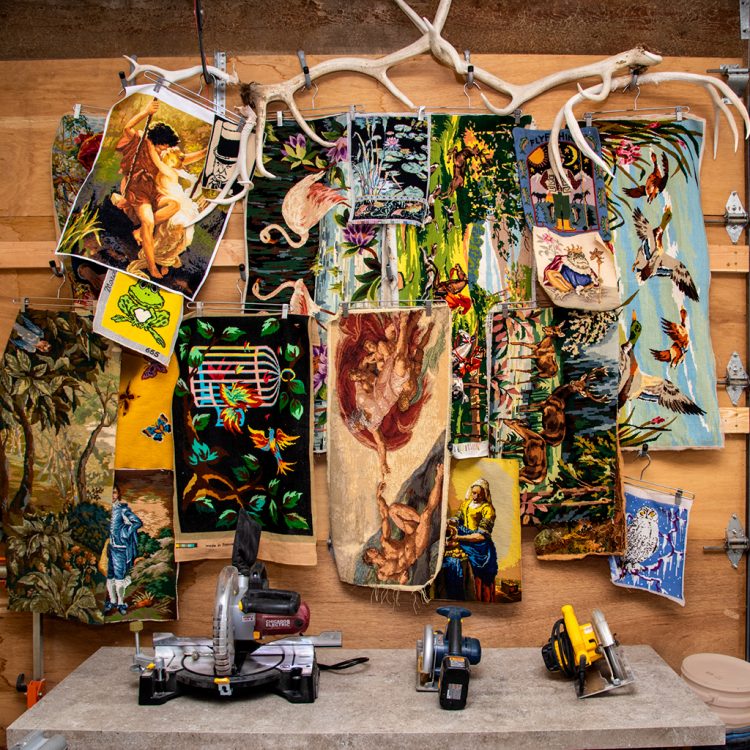
Tools and art supplies have accumulated over the years in a somewhat orderly fashion, but while the physical space has remained the same, the use and function of different areas have evolved over time. The most recent studio addition is a large two-sided rolling wall where I can mull over works in progress or display finished pieces for visitors.
As I am an untidy artist, current projects often overlap on countertops, and materials are seldom put away while a work is in progress. I’m forever trying to wipe down countertops before guests arrive, although I am repeatedly assured by my visitors that work surfaces piled up with current projects are far more interesting than clean and tidy ones.
I have been to many art studios, from the small and modest to the large and industrial, and even extravagantly furnished studios that also serve as galleries. When designing my own studio space, it never occurred to me that I might ever need the wine bar or sofas that I had seen in other studios. It seems hard enough to keep the gunk off the chairs that I sit in myself.
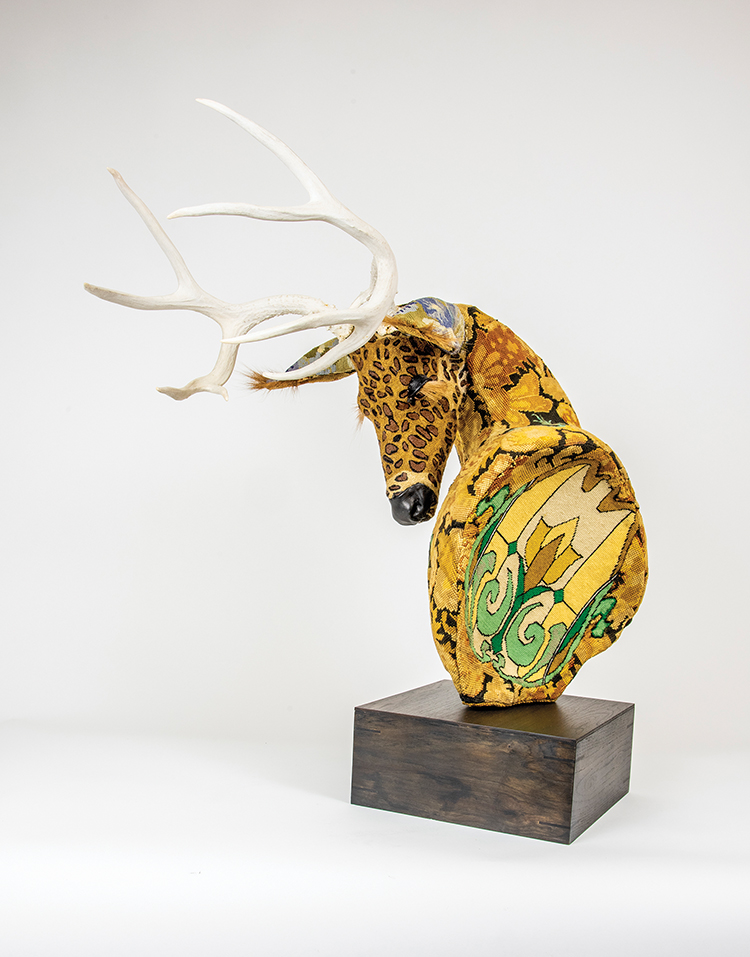
And yet, I feel that the very least I can do for a well-dressed gallery owner or group of friends who want to see what’s new in the studio is to offer a clean seat and a cup of coffee or glass of wine. I throw tablecloths over paint-stained counters, and there are clean and comfortable chairs that hang on the wall, Amish style. I never planned for visitors to my studio but am delighted by the chance to meet interested students, other artists and gallery professionals in my workspace.
Today, I am able to call myself an artist and not feel like an imposter. I’m not sure if that has to do with the number of lines on a CV or years on the planet. Either way, the angst I felt as an emerging artist is largely gone, and the work continues to progress. Walking into my studio feels right and brings me great joy. The privilege of having a dedicated space where I can pursue my passion and share it with others is not something I take for granted. I also no longer wonder whether my work warrants such a place and, instead, am grateful for the space I have created that enables my work to emerge and find its place in the world.
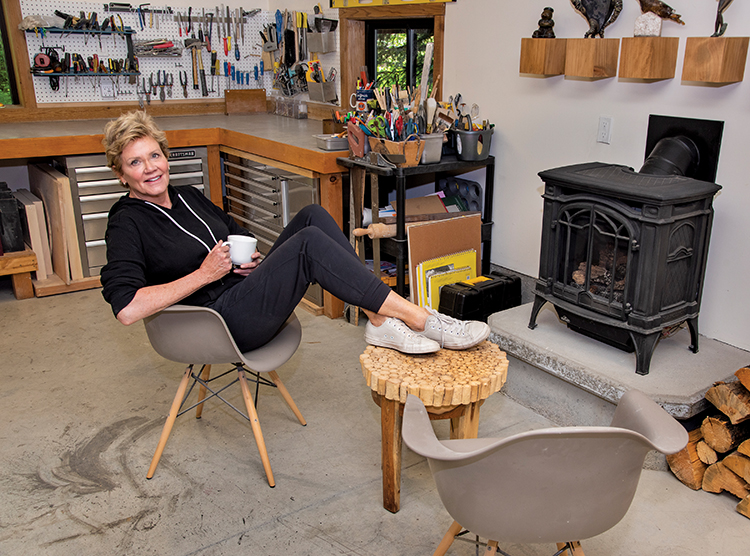

Makers have a way of finding spaces in which to create. Whether on their laps in front of the television, on kitchen tables cleared before dinner, in garages and basements, or yards and laundry rooms, artists find spaces to make their work. By necessity, I have created art in all these places. Today, I have a designated studio attached to my home that is my creative space and my sanctuary — but it wasn’t always that way.
I have been a maker for as long as I can remember. From homemade paper dolls drawn with crayons and cut out with children’s scissors to museum installations, I have had what I call busy hands. My adolescent bedroom was my first studio. Filled with macramé projects rigged to the hanging rod in my closet and combustible candle-making supplies — it was the ’70s, after all — my purple-painted bedroom was my first creative space.
Later, my dorm room became the place where assignments from college art professors were tackled. Trying, mostly unsuccessfully, to keep to my half of the tiny room, I stacked large canvases against the wall and piled toxic painting supplies in the corner. I painted while sitting cross-legged on the floor and cleaned paintbrushes in the communal bathroom down the hall.
Today, I would consider these hardships, though that never occurred to me at the time. In reality, I think this is just how art is always made — in the space available.
During those student years, whenever I wasn’t making art, I was trying to figure out how I might make a living in the world. As graduation approached, my romantic idea of supporting myself by painting in a loft in SoHo soon gave way to the imminent and pressing reality of monthly rent and car payments. The pursuit of a career in fine art turned into the next-most-palatable idea — graphic design.

Later, I was to learn from colleagues in the advertising and design field that they had made similar pivots to become employable. The sad trade-off that I witnessed, however, was that with long workdays and adult commitments at home, few of us were creative in our off-hours.
Years later, when motherhood kept me home with young children, I began to sketch during naptime. Drawing was the one creative outlet that didn’t require a designated space, wasn’t messy, and didn’t require lengthy cleanup — crucial elements for the short and unpredictable time spans available to me. Interestingly, instead of making traditional two-dimensional sketches from my imagination or my immediate surroundings, I found myself drawing three-dimensional objects, essentially trying to compress sculpture onto a page. This initial connection to sculpture was a eureka moment for me and led to much of the work I create today.
As soon as my children entered school, I purchased a bag of clay and never looked back. I bought a kiln and checked out library books — remember those, before YouTube videos? — on how to sculpt and fire clay. My studio was in the mudroom off the laundry room, and as appropriate as that sounds for working with clay, it was a tiny space without a sink. Clay sculptures were set to dry in the laundry room — where else but on the dryer? During this time of experimentation in three dimensions with an unfamiliar material, I began to find my voice — and my nerve.
Up to this point, I would never have called myself an artist, at least not out loud. A maker, a creative spirit perhaps, but not an artist. An artist, a real artist, has to have work in galleries. Or so I thought. I feared that if I called myself an artist, people would ask, “Where is your work being shown?” For years, much of my work was gifted to (or foisted on) friends and relatives, not sold in galleries. To this day, I sometimes find that early work in the homes of friends and family and cringe.
“Inspiration exists, but it has to find you working.”
— Pablo Picasso
At a certain point, I realized that my art could not mature without some critical input, so I made the commitment to return to school. Pursuing a graduate degree in middle age had a significance for me beyond my initial intentions. I was after the same MFA as my younger peers, and I was interested in academic challenge for its own sake, but what I also received was an eye-opening look at my own work and a kick in the pants.
In school, I was exposed to conceptual work and rigorous art theory. I began to think about my work instead of just making it. Additionally, for the first time in my life, I committed to creating a workspace that nurtured me.
Studio is a word used in a number of different disciplines.
When people enter my studio, they generally call it a workshop. It looks like a cross between a woodshop, an elementary school art room and an artist’s studio. It began as a large three-and-a-half-car garage attached to my home.
Unwilling to give up all my indoor parking space in the snowy mountains of Idaho, I shrunk my garage to a single space and walled off the rest. I don’t have to scrape ice from my car windows on winter mornings, and my spacious studio is now the size of a two-and-a-half-car garage. The addition of a large window and a wood stove for supplemental heat makes the space warm and bright and an inviting place to work.
Because my work is sculptural and often changes in size and material, I need large work surfaces and lots of storage. There is a designated area for power tools to cut wood, metal and plastic as needed. Over the years, I have added a table saw, band saw, drill press and more, so I no longer need to hire out small construction or assembly aspects of my work. I also installed an exhaust hood for the toxic fumes from epoxy resin and adhesives, and, most importantly, constructed large storage areas for paints, stains, mold-making materials and waxes. This space is used for corralling leftovers from past projects or storing materials needed for future ones.

Tools and art supplies have accumulated over the years in a somewhat orderly fashion, but while the physical space has remained the same, the use and function of different areas have evolved over time. The most recent studio addition is a large two-sided rolling wall where I can mull over works in progress or display finished pieces for visitors.
As I am an untidy artist, current projects often overlap on countertops, and materials are seldom put away while a work is in progress. I’m forever trying to wipe down countertops before guests arrive, although I am repeatedly assured by my visitors that work surfaces piled up with current projects are far more interesting than clean and tidy ones.
I have been to many art studios, from the small and modest to the large and industrial, and even extravagantly furnished studios that also serve as galleries. When designing my own studio space, it never occurred to me that I might ever need the wine bar or sofas that I had seen in other studios. It seems hard enough to keep the gunk off the chairs that I sit in myself.

And yet, I feel that the very least I can do for a well-dressed gallery owner or group of friends who want to see what’s new in the studio is to offer a clean seat and a cup of coffee or glass of wine. I throw tablecloths over paint-stained counters, and there are clean and comfortable chairs that hang on the wall, Amish style. I never planned for visitors to my studio but am delighted by the chance to meet interested students, other artists and gallery professionals in my workspace.
Today, I am able to call myself an artist and not feel like an imposter. I’m not sure if that has to do with the number of lines on a CV or years on the planet. Either way, the angst I felt as an emerging artist is largely gone, and the work continues to progress. Walking into my studio feels right and brings me great joy. The privilege of having a dedicated space where I can pursue my passion and share it with others is not something I take for granted. I also no longer wonder whether my work warrants such a place and, instead, am grateful for the space I have created that enables my work to emerge and find its place in the world.







